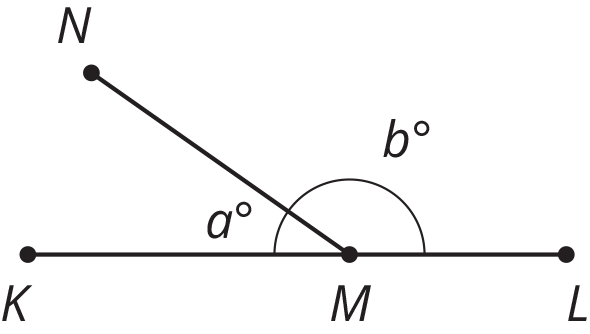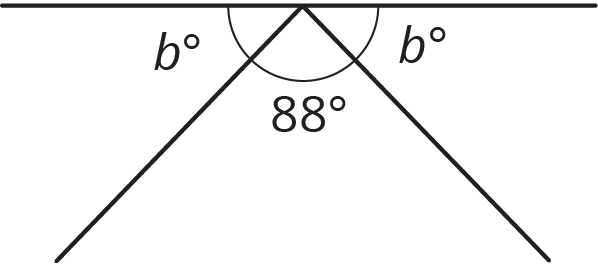Lesson 4
Solving for Unknown Angles
Problem 1
\(M\) is a point on line segment \(KL\). \(NM\) is a line segment. Select all the equations that represent the relationship between the measures of the angles in the figure.

\(a=b\)
\(a+b=90\)
\(b=90-a\)
\(a+b=180\)
\(180-a=b\)
\(180=b-a\)
Solution
For access, consult one of our IM Certified Partners.
Problem 2
Which equation represents the relationship between the angles in the figure?

\(88+b=90\)
\(88+b=180\)
\(2b+88=90\)
\(2b+88=180\)
Solution
For access, consult one of our IM Certified Partners.
Problem 3
Segments \(AB\), \(EF\), and \(CD\) intersect at point \(C\), and angle \(ACD\) is a right angle. Find the value of \(g\).

Solution
For access, consult one of our IM Certified Partners.
Problem 4
Select all the expressions that are the result of decreasing \(x\) by 80%.
\(\frac{20}{100}x\)
\(x - \frac{80}{100}x\)
\(\frac{100-20}{100}x\)
\(0.80x\)
\((1-0.8)x\)
Solution
For access, consult one of our IM Certified Partners.
(From Unit 6, Lesson 12.)Problem 5
Andre is solving the equation \(4(x+\frac32)=7\). He says, “I can subtract \(\frac32\) from each side to get \(4x=\frac{11}{2}\) and then divide by 4 to get \(x=\frac{11}{8}\).” Kiran says, “I think you made a mistake.”
- How can Kiran know for sure that Andre’s solution is incorrect?
- Describe Andre’s error and explain how to correct his work.
Solution
For access, consult one of our IM Certified Partners.
(From Unit 6, Lesson 8.)Problem 6
Solve each equation.
\(\frac17a+\frac34=\frac98\)
\(\frac23+\frac15b=\frac56\)
\(\frac32=\frac43c+\frac23\)
\(0.3d+7.9=9.1\)
\(11.03=8.78+0.02e\)
Solution
For access, consult one of our IM Certified Partners.
(From Unit 6, Lesson 7.)Problem 7
A train travels at a constant speed for a long distance. Write the two constants of proportionality for the relationship between distance traveled and elapsed time. Explain what each of them means.
| time elapsed (hr) | distance (mi) |
|---|---|
| 1.2 | 54 |
| 3 | 135 |
| 4 | 180 |
Solution
For access, consult one of our IM Certified Partners.
(From Unit 2, Lesson 5.)